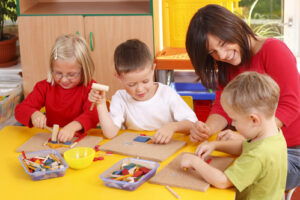
5 Effective Ways to Teach Rhyming

Working with rhymes can be fun for children and can also give them a sense of confidence in their language skills. Rhyming provides children with invaluable practice in identifying and saying words that have a common sound and teachers with the opportunity to assess children’s ability to do so. Emergent readers, who are beginning to recognize letters, understand that writing has meaning, and listen to words more closely, can benefit from being exposed to and interacting with rhyming songs and books. As children become more adept in hearing words and syllables, they can play more complex and challenging rhyming games. Here are five effective and fun ways to teach rhyming:
1. Repetitive Poetry
Choose a rhyming poem or nursery rhyme that fits into a topic your class is already studying. Focus on it throughout a week to give students an in-depth experience with rhyming. When you first read the rhyming poem to them, exaggerate the rhyming syllables and the sounds of the rhyme. Then, line by line, they can repeat the poem back to you. As you repeat this activity, children’s recall of the poem will improve and they will be able to fill in the rhyming word at the end of a line when you leave it out. Children sometimes enjoy choral recitation of a poem in which the class varies the volume of speech, such as saying the poem in a normal voice but the rhyming words in a whisper, or vice versa. Children can also illustrate the poem and practice writing the rhyming words, depending on their writing level.
2. Name Nonsense Rhyming
Because every child knows their name and is often proud of it, incorporating their names into rhyming activities is a natural and enjoyable choice. It is fun for the kids because many of their names will not have a real word that rhymes with them and so they will get to make up a silly rhyme. For example, each child can recite, “My name is Johnny and I want to eat a … zonny,” wherein each one gets to make up a nonsense food name that rhymes with their name. They might then want to explain what a zonny is or draw it.
3. Rhyming Box
A rhyming box is a fun extension of nonsense rhyming that involves 3-D props. Real rhymes may be used with a rhyming box as well. A box should be filled with small objects that children can hold in their hands (at least one for each child). The teacher then challenges the students to find the object whose name rhymes with the word he says. So, if the teacher says, “snape,” the student must pick out the tape.
4. Rhyming Picture Cards
Labeled pictures of words that rhyme that are either printed, made by students or teachers, or purchased, can be used for lots of rhyming games. Students can sort words that rhyme into piles or play games that require rhyme matching, like Memory or Go Fish. Another extension of the rhyming picture cards is rhyming bingo. The University of Virginia’s Phonological Awareness Literacy Screening (PALS) program offers a rhyming bingo template here. Prekinders also offers a free printable to make your own rhyming dice.
5. Rhyme Writing Challenge
Children who are able to independently write down sets of rhyming words can engage in a challenge to see how many rhymes they can write in three minutes. They can either write down any pairs of rhymes they can think of or respond to a teacher prompt, such as, words that rhyme with cat. These rhyme-writing challenges can also be subject specific–if you are learning about weather, children might have to come up with rhymes for wind or rain. Children can work alone or in pairs or teams. Later, they can read their lists out loud or write them onto a poster of rhymes to display in the room. If children then illustrate their rhymes on notecards or the like, they can end up with a new set of handmade rhyming cards to play with.
So, remember that teaching rhyming can be multidisciplinary and fun.
Written by Julia Travers
Contact us today to learn more about how our tutors can help your young child learn their basic words, letters and sounds!
Tag:rhyming



